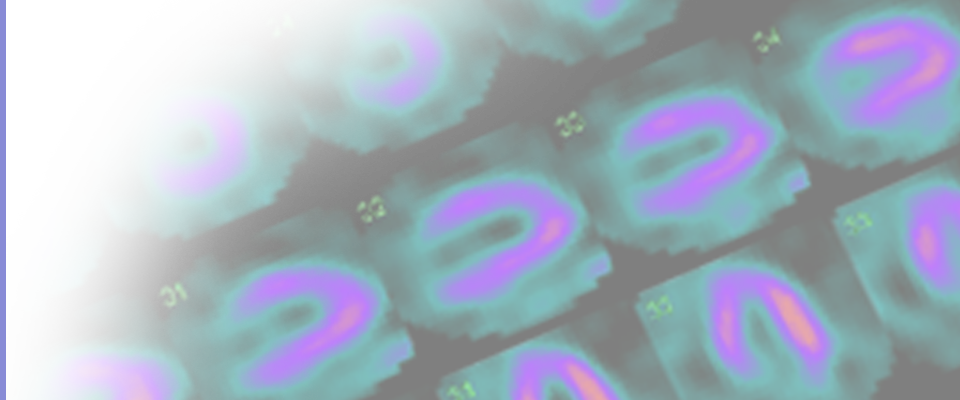CME, CBNC Board Prep or ICANL Re-Accreditation
This course is a comprehensive online Self-Study program for physicians practicing nuclear medicine or studying to take the CBNC exam. The materials will be presented in an on-line format where the student will evaluate didactic material, images and animations relevant to the study of Nuclear Cardiology.
Each course topic concludes with an interactive quiz to guage the learner's retention of the materials presented.

Additional Course Information
2) Discuss Reconstruction, Reorientation, Segmentation, Sampling, Polar Maps & Quantitative Perfusion.
3) Improve identification and handling of Errors and Artifacts.
4) Identify motion artifacts, regional & diffuse soft tissue attenuation and reconstruction artifacts.
5) Proper usage of motion and attenuation correction.
6) Explain how a gamma camera works and how SPECT images are formed in relation to collimation, crystal technology, photomultiplier tubes and essential electronic components.
7) The application of solid state detectors in nuclear cardiology.
8) Evaluate NEMA recommendations and identify artifacts in nuclear cardiology quality control.
9) Identify proper image interpretation and artifact in rotating planar imaging.
10) Interpret standard nomenclature and slice orientation in SPECT imaging.
11) Analysis of volumes & ejection fraction and identifying wall motion & thickening in Gated SPECT imaging.
12) Quantitative and Qualitative assessments in image interpretation.
13) Applying the characteristics of individual tracers, concepts of tracer kinetics, extraction, distribution, retention and radiation physics of radiopharmaceuticals in nuclear cardiology.
14) Addressing radiation safety concerns in nuclear cardiology in regard to: terminology, time, distance, shielding, biological effects, monitoring, occupational exposure, stochastic effects and deterministic effects.
15) ALARA dose considerations.
16) Compare and contrast exercise and pharmacologic stress testing options in terms of application, accuracy, strengths and weaknesses.
17) Imaging protocols in Nuclear Cardiology under administration of Thallium and TC-99m.
18) Apply principles of nuclear cardiology to board exam preparation.
19) Apply principles of dose versus scan time, radiation units and radiation from nuclear medicine studies. 20) Differentiate types of ionizing radiation, biological, physical, and effective half-life and an overall general approach to managing dose.
21) Recognize crystal technology/camera design, reconstruction algorithms, new radiotracers and Imaging protocols in nuclear medicine.
22) Evaluate special considerations with pediatric patients, modified dose chart and Image quality.
23) Identify future directions regarding the co-evolution of camera technology, software, and hardware as well as a multi-faceted approach to dose reduction.
24) A comprehensive background in Mo/Tc and Sr/Rb generators as well as functionality and special considerations.
25) Discuss the Rb-82 generators as a paradigm for the principles in generator safety.
26) The participant should recognize the rationale and implication surrounding the FDA recall of the Rb-82 generator for PET myocardial perfusion imaging.
27) The participant should be able to differentiate SPECT vs PET imaging, understand basic PET physics, identify components of a PET camera, understand image processing, reconstruction, stress protocols as well as the perfusion and viability of radiotracers.
28) Review multiple gated acquisition scan techniques in the evaluation of ventricular function.
29) Apply and expand upon principles of nuclear cardiology to board exam preparation.
MD Training faculty believe that in this ever changing medical environment where imaging is heavily scrutinized and ever evolving, continued education as well as board certification and recertification in Nuclear cardiology will become ever more important to assure competence, cutting edge practice, reimbursement and credentialing. Guideline based medicine practice is clearly the trend in this and all fields especially when prescribing diagnostic radiation. Ever awareness of radiation exposure is mandatory. This course’s content covers these techniques and protocols, which are ever evolving, and outlines their applications to the participant.
Director of Clinical Education
MD Training @home, LLC
Board certified in Internal Medicine and Cardiology
Subspecialty board certification: Echocardiography, Nuclear Cardiology, Vascular Imaging
The University of Arizona College of Medicine – Tucson designates this enduring materials activity for a maximum of 20 AMA PRA Category 1 Credit(s)TM. Physicians should claim only the credit commensurate with the extent of their participation in the activity.
Current CME Approval Period: 5/26/2025 to 5/25/2027
Date of Last Review: 5/26/2025
Original Release Date: 8/09/2009
Commercial Support: None
UA Continuing Medical Education
PO Box 245121
Tucson, AZ, 85724-5121
(520)626-7832
FAX (520)626-2427
uofacme@u.arizona.edu
www.ocme.arizona.edu
All individuals in a position to control the content of this CME activity have disclosed that they have no relevant financial relationships with ineligible companies that would constitute a conflict of interest concerning this CME activity.